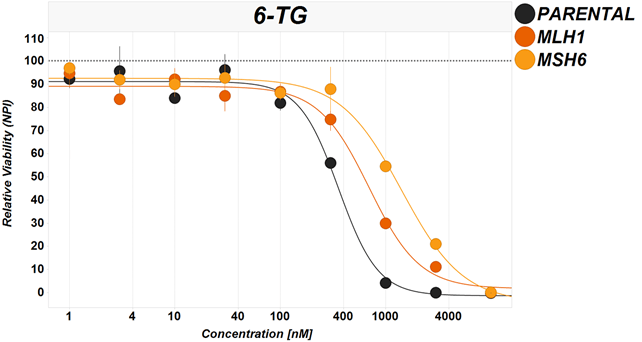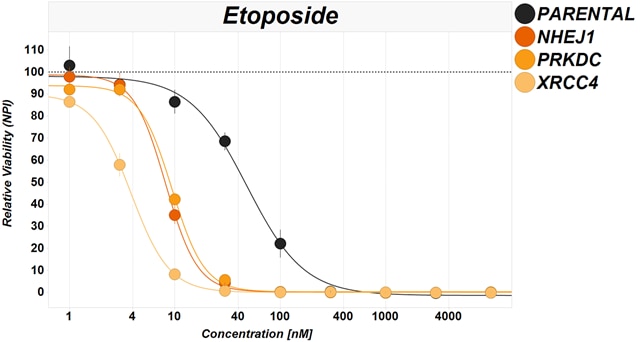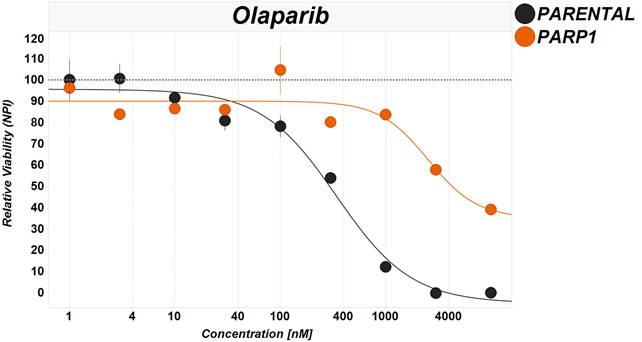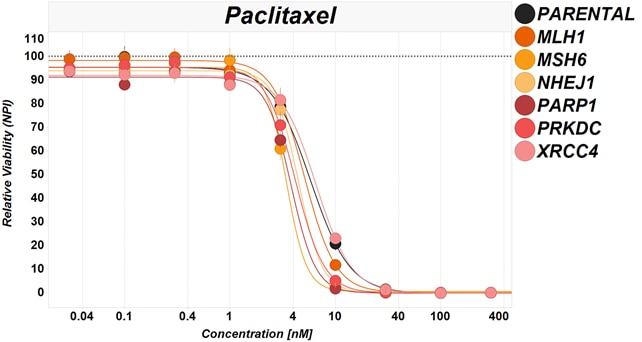Sensitivity and resistance to DNA damage response pathways identified with gene-edited cell lines and wildtype controls
The cellular DNA damage response (DDR) is an essential safeguard against cancer. Upon activation, the DDR can limit tumor progression at the early stages by inducing senescence or cell death. When this defense fails tumors are able to develop. However, with time, tumors accumulate more mutations in DNA repair proteins as cancers progress. The efficiency of DDR plays an essential role in the effectivity of cytotoxic treatments. Currently much research is focused on identifying the DDR mechanisms involved in cancers and how these dysfunctional processes can be utilized against tumor growth.
Here, a selection of HAP1 knockout cell lines are used to confirm involvement of particular DDR pathways in a compounds' mode of action and demonstrate opportunities for the exploitation of synthetic lethal interactions, using a 96 hour proliferation assay.
DNA mismatch repair (MMR) system - 6TG
6-thioguanine (6-TG) is a growth inhibitory antimetabolite which requires an active DNA mismatch repair (MMR) system to be effective. Defects in key proteins including MLh2 or MSH6 confer resistance to the cytotoxic effects. as demonstrated by resistance to 6TG in Hap1 knockout cell lines shown below:

DNA Damage 6TG HAP1
DNA double strand breaks (DSBs) - Etoposide
This compound blocks DNA replication of rapidly dividing cells though the inhibition of replication proteins, such as topoisomerase, via DNA double strand breaks (DSBs). Non-homologous end-joining (NHEJ) is the predominant pathway for the repair of DSBs in human cells. PRKDC, NHEJ1 and XRCC4 are essential to NHEJ mediated repair, as reflected by the sensitivity of the HAP1 cell line to etoposide when these genes are disabled, as shown below:

DNA Damage Etoposide HAP1
Single strand break (SSB) repair - Olaparib
The PARP family of proteins are involved in multiple DNA damage response pathways, including base excision repair (BER) and single strand break (SSB) repair pathways, as well as influencing homologous recombination (HR) and non-homologous end-joining (NHEJ) repair of double strand breaks (DSB). Olaparib, a PARP inhibitor, disrupts the repair of single-strand DNA breaks so leading to DNA damage overload and cell death. PARP-1 is the principle PARP responder to DNA damage and resistance to Olaparib conferred to PARP1 knockout HAP1 cell lines as expected, as shown below:

DNA Damage Olaparib HAP1
Control - Paclitaxel
As a control, gene-edited cell lines and the wildtype parental control were exposed to the chemotherapy drug Paclitaxel, which works by interference with the normal function of microtubules during cell division.

DNA Damage Paclitaxel HAP1
Cell line models for the study of DDR
These examples show how horizon's Cell Lines allow single genetic modifications to be studied in isolation. The cell lines used in this study are available from the cell line catalog and are listed below, together with other knockout cell lines relevant for DDR.

DNA Damage Cell Lines HAP1
You may be interested to know that Horizon has a panel of knockouts that target all 17 PARP genes.
